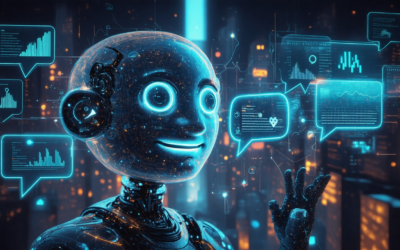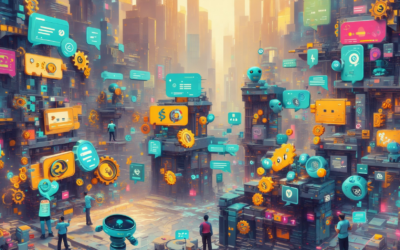Key Takeaways
- Understanding Chatbots: Chatbots simulate human-like conversations, utilizing AI and Natural Language Processing (NLP) to enhance user interactions.
- Types of Chatbots: Chatbots are categorized into rules-based and AI-powered systems, each with unique functionalities and applications.
- 24/7 Support: Chatbots provide round-the-clock assistance, significantly improving customer service efficiency and satisfaction.
- Cost Efficiency: Automating inquiries with chatbots reduces operational costs and frees human agents for complex tasks.
- Data Insights: Chatbots gather valuable user data, helping businesses refine their services and marketing strategies.
- Real-World Applications: Chatbots are utilized in various sectors, including customer service, healthcare, education, and e-commerce, demonstrating their versatility.
- Pros and Cons: While chatbots enhance efficiency and engagement, they may lack emotional intelligence and struggle with complex queries.
In today’s digital landscape, a chatbot has emerged as a pivotal tool, revolutionizing the way we interact with technology. But what is a chatbot? This article delves into the definition and meaning of chatbots, exploring their evolution and significance in our daily lives. We will also examine the intriguing question: Is Siri a chatbot or an AI assistant? By understanding the role of natural language processing, we can differentiate between chatbots and AI assistants like Siri and Alexa. Additionally, we will provide practical insights on how to use ChatGPT effectively, highlighting its applications and comparing it to traditional chatbots. As we navigate through the functionalities of Alexa as a chatbot, we will weigh the pros and cons of using chatbots in business, addressing whether they are a good or bad thing. Furthermore, we will explore the availability of free chatbot options and the costs associated with developing one. Finally, we will showcase real-world examples of chatbots across various industries and discuss the rise of chatbot apps in mobile technology. Join us as we uncover the multifaceted world of chatbots and their impact on our lives.
What is a chatbot?
A chatbot is an advanced software application designed to simulate human-like conversations through text or voice interactions. Here’s a comprehensive overview:
- Human-like Conversation: Chatbots are engineered to mimic natural dialogue, utilizing sophisticated algorithms to generate responses that feel realistic and engaging.
- Automated Interaction: They can perform a variety of tasks, ranging from answering basic inquiries to executing complex actions such as making reservations or offering personalized recommendations.
- AI and Natural Language Processing (NLP): Many chatbots leverage artificial intelligence and NLP technologies to comprehend user inputs and produce human-like responses. This allows for a more intuitive interaction experience.
- Diverse Applications: Chatbots are utilized across multiple sectors, including customer service, education, marketing, healthcare, and entertainment, enhancing operational efficiency and user engagement.
- Types of Chatbots: There are two primary categories:
- Rules-based Chatbots: These operate on predefined scripts and respond to specific keywords.
- AI-powered Chatbots: These systems utilize machine learning to adapt and improve over time, learning from interactions to provide more accurate responses.
- User Interaction Process:
- User Input: Users engage with chatbots via text or voice commands.
- Processing: The chatbot analyzes the input to discern the user’s intent using AI or rule-based logic.
- Response Generation: Based on this analysis, the chatbot formulates a relevant response.
- User Interaction Continuation: The chatbot delivers the response, allowing for an ongoing conversational cycle.
- 24/7 Availability: Chatbots can operate continuously, providing support without the need for human agents, which is particularly beneficial for businesses with global customers.
- Cost Savings: By automating repetitive tasks, chatbots can significantly reduce the need for extensive human resources, leading to lower operational costs.
- Improved Efficiency: Chatbots can manage routine inquiries, allowing human agents to concentrate on more complex issues, thus enhancing overall productivity.
- Enhanced Customer Experience: By delivering quick and personalized assistance, chatbots can significantly boost customer satisfaction and loyalty.
- Data Collection: Chatbots can gather valuable insights into user behavior and preferences, which can be leveraged to refine products and services.
- Examples of Chatbots:
- Virtual Assistants: Siri (Apple), Alexa (Amazon), and Google Assistant exemplify how chatbots can assist users in daily tasks.
- Customer Service Bots: Many companies deploy chatbots on their websites or messaging platforms to handle customer inquiries efficiently.
- Educational Bots: Chatbots can serve as interactive teaching tools, offering personalized learning experiences tailored to individual student needs.
- Game Bots: In the gaming industry, chatbots can be integrated into video games to create interactive non-playable characters (NPCs) that enhance player engagement.
In summary, chatbots represent a transformative technology that enhances communication, improves efficiency, and provides valuable insights across various industries. For further reading on the impact and evolution of chatbots, refer to sources such as the Journal of Artificial Intelligence Research and industry reports from Gartner.
The evolution of chatbots in technology
The evolution of chatbots has been marked by significant technological advancements that have transformed their capabilities and applications. Initially, chatbots were simple rule-based systems that could only respond to specific commands. However, with the advent of artificial intelligence and machine learning, chatbots have evolved into sophisticated tools capable of understanding context, sentiment, and user intent.
- Early Developments: The first chatbots, such as ELIZA in the 1960s, were designed to mimic human conversation but lacked true understanding. They operated on scripted responses, limiting their effectiveness.
- Introduction of AI: The integration of AI technologies in the 2000s allowed chatbots to learn from interactions, improving their responses over time. This shift enabled the development of more complex AI-powered chatbots that could handle a wider range of inquiries.
- Natural Language Processing (NLP): Advances in NLP have been crucial in enhancing chatbot interactions. By enabling chatbots to understand and process human language more effectively, NLP has made conversations feel more natural and engaging.
- Current Trends: Today, chatbots are utilized in various industries, from customer service to healthcare, and are increasingly integrated with platforms like social media and messaging apps. Their ability to provide real-time assistance and gather data has made them invaluable tools for businesses.
As technology continues to advance, the future of chatbots looks promising, with potential developments in areas such as emotional intelligence and deeper contextual understanding. For more insights into the evolution of chatbots, explore this comprehensive guide.

Is Siri a Chatbot or AI?
Siri is a virtual assistant developed by Apple Inc., utilizing artificial intelligence (AI) technologies to perform tasks and provide information through voice commands. Originally a project of SRI International’s Artificial Intelligence Center, Siri incorporates advanced speech recognition capabilities, initially powered by Nuance Communications.
Siri functions as a conversational agent, often referred to as a chatbot, due to its ability to engage in dialogue and respond to user inquiries. However, it is more accurately described as an AI-driven virtual assistant because it leverages machine learning algorithms to understand context, learn user preferences, and improve responses over time.
Understanding AI Assistants: Siri vs. Chatbots
When comparing Siri to traditional chatbots, it’s essential to recognize the differences in their functionalities. While both can engage users in conversation, Siri’s advanced capabilities set it apart. Key features of Siri include:
- Natural Language Processing (NLP): Siri employs NLP to interpret user commands and questions, allowing for more intuitive interactions.
- Contextual Awareness: The assistant can provide personalized responses based on user history and location, enhancing the relevance of its answers.
- Integration with Smart Devices: Siri can control smart home devices, making it a central hub for home automation.
Recent advancements in AI and machine learning have further improved Siri’s capabilities, enabling it to handle more complex queries and provide more accurate information. For instance, studies show that AI assistants are increasingly able to understand nuances in human speech, making them more effective in real-world applications (source: Stanford University, “The Future of AI in Everyday Life”).
The Role of Natural Language Processing in Chatbots
Natural Language Processing is a critical component in the functionality of chatbots. It allows these automated systems to understand and respond to user inquiries in a human-like manner. Chatbots, such as those integrated into customer service platforms, utilize NLP to interpret user intent and provide relevant answers. This technology is essential for enhancing user experience and ensuring effective communication.
For more insights on chatbots and their definitions, you can explore chatbots definition and what are chatbots.
Is Chatbot a Good or Bad Thing?
When considering whether a chatbot is beneficial or detrimental, it’s essential to weigh the pros and cons of using chatbots in business settings. Understanding the pros and cons of chatbots can help businesses make informed decisions about their implementation.
The Pros and Cons of Using Chatbots in Business
- Pros:
- 24/7 Availability: Chatbots can provide round-the-clock support, ensuring that customer inquiries are addressed at any time.
- Cost-Effective: By automating responses, businesses can reduce labor costs associated with customer service.
- Scalability: Chatbots can handle multiple interactions simultaneously, making them ideal for businesses experiencing high volumes of inquiries.
- Improved Customer Engagement: Engaging users through personalized interactions can enhance customer satisfaction and loyalty.
- Cons:
- Lack of Human Touch: Some customers may prefer human interaction, especially for complex issues that require empathy.
- Limited Understanding: Chatbots may struggle with nuanced queries or slang, leading to frustration for users.
- Dependence on Technology: Technical issues can disrupt service, potentially harming customer relationships.
User Experiences: Chatbots in Customer Service
User experiences with chatbots can vary widely. Many users appreciate the quick responses and efficiency that chatbots offer, especially for straightforward inquiries. However, others may express dissatisfaction when their questions are not adequately addressed. For instance, a recent survey indicated that while 70% of users found chatbots helpful for basic questions, only 30% felt satisfied with their experience when dealing with more complex issues.
To enhance user experiences, businesses should consider integrating advanced AI chatbots that utilize natural language processing (NLP) to better understand and respond to customer inquiries. This approach can bridge the gap between automated responses and the human touch that many customers seek.
Is Chatbot a Good or Bad Thing?
When considering the impact of chatbots on businesses and consumers, it’s essential to weigh the pros and cons. Understanding the benefits and drawbacks of chatbots can help organizations make informed decisions about their implementation.
The Pros and Cons of Using Chatbots in Business
Chatbots have revolutionized customer interaction, offering numerous advantages:
- 24/7 Availability: Chatbots provide round-the-clock support, ensuring customers can get assistance at any time.
- Cost Efficiency: By automating responses, businesses can reduce operational costs associated with customer service.
- Scalability: Chatbots can handle multiple inquiries simultaneously, making them ideal for businesses with high volumes of customer interactions.
- Improved Customer Experience: Quick responses and personalized interactions enhance user satisfaction.
However, there are also challenges to consider:
- Limited Understanding: Chatbots may struggle with complex queries, leading to frustration for users.
- Impersonal Interaction: Some customers prefer human interaction, which chatbots cannot replicate.
- Technical Issues: Bugs or failures in the chatbot system can disrupt service and damage brand reputation.
User Experiences: Chatbots in Customer Service
User experiences with chatbots can vary widely. Many appreciate the speed and efficiency of automated responses, while others express dissatisfaction when their needs are not met. For instance, a recent survey indicated that 70% of users found chatbots helpful for simple inquiries, but only 30% felt satisfied with their performance on more complex issues.
To maximize the effectiveness of chatbots in customer service, businesses should:
- Continuously improve the chatbot’s AI capabilities through machine learning.
- Provide an option for users to connect with a human representative when needed.
- Regularly gather feedback to enhance the chatbot’s performance and user satisfaction.
In conclusion, while chatbots present both advantages and challenges, their role in enhancing customer service is undeniable. By understanding user experiences and addressing potential drawbacks, businesses can effectively leverage chatbots to improve engagement and operational efficiency.

Is Chatbot a Good or Bad Thing?
Chatbots have become a staple in modern business communication, offering both benefits and challenges. Understanding the pros and cons of using chatbots can help businesses make informed decisions about their implementation and usage.
The Pros and Cons of Using Chatbots in Business
Chatbots have become increasingly prevalent in customer service and engagement, offering both advantages and disadvantages. Here’s a comprehensive look at the implications of using chatbots:
- Advantages of Chatbots:
- 24/7 Availability: Chatbots can provide round-the-clock support, ensuring customers receive assistance at any time, which enhances user satisfaction and engagement.
- Cost Efficiency: Implementing chatbots can significantly reduce operational costs for businesses by automating routine inquiries and freeing up human agents for more complex tasks.
- Quick Response Times: Chatbots can handle multiple inquiries simultaneously, providing instant responses that improve customer experience and reduce wait times.
- Data Collection and Insights: Chatbots can gather valuable data on customer preferences and behaviors, allowing businesses to tailor their services and improve marketing strategies.
- Disadvantages of Chatbots:
- Limited Emotional Intelligence: While chatbots can manage basic interactions, they often lack the empathy and understanding required for complex customer service situations. According to a survey by PwC, 60% of consumers feel that human agents better understand their needs than chatbots.
- Frustration with Complex Queries: Customers may become frustrated when chatbots fail to comprehend or resolve intricate issues, leading to a negative experience.
- Dependence on Technology: Over-reliance on chatbots can lead to a decline in human interaction, which is essential for building strong customer relationships.
User Experiences: Chatbots in Customer Service
Customer experiences with chatbots can vary widely based on their design and implementation. Here are some insights into how users perceive chatbots in customer service:
- Positive Experiences: Many users appreciate the quick responses and 24/7 availability that chatbots provide, especially for simple inquiries. This immediacy can enhance overall satisfaction.
- Negative Experiences: Conversely, users often express frustration when chatbots fail to understand their queries or provide irrelevant answers. This can lead to dissatisfaction and a preference for human interaction.
- Hybrid Solutions: Some businesses have found success by combining chatbots with human agents, allowing for seamless transitions when complex issues arise. This approach can improve user satisfaction and maintain a personal touch.
In conclusion, chatbots can be both beneficial and detrimental depending on their implementation and the context in which they are used. Businesses should weigh these factors carefully to maximize the advantages while mitigating the drawbacks. For further insights on chatbot effectiveness, refer to studies from sources like PwC and McKinsey & Company, which provide in-depth analyses of customer preferences and technology trends.
Is chatbot a good or bad thing?
The debate over whether chatbots are beneficial or detrimental to businesses and users is ongoing. Understanding the pros and cons of using chatbots can help organizations make informed decisions about their implementation. Here’s a closer look at the advantages and disadvantages of chatbots in business.
The pros and cons of using chatbots in business
Chatbots offer numerous benefits, but they also come with certain drawbacks. Here’s a breakdown:
- Pros:
- 24/7 Availability: Chatbots can provide round-the-clock support, ensuring that customer inquiries are addressed at any time.
- Cost Efficiency: By automating responses, businesses can reduce labor costs associated with customer service.
- Scalability: Chatbots can handle multiple interactions simultaneously, making them ideal for high-traffic situations.
- Consistency: They deliver uniform responses, reducing the risk of human error and ensuring a consistent customer experience.
- Cons:
- Lack of Human Touch: Chatbots may struggle to understand complex queries or provide empathetic responses, leading to frustration for users.
- Limited Understanding: Many chatbots rely on predefined scripts, which can limit their ability to handle unexpected questions.
- Technical Issues: If not properly maintained, chatbots can malfunction, leading to poor user experiences.
- Dependency on Technology: Over-reliance on chatbots may lead to neglecting the importance of human customer service representatives.
User experiences: Chatbots in customer service
User experiences with chatbots can vary widely. Many users appreciate the quick responses and availability, especially for simple inquiries. However, others express frustration when chatbots fail to understand their needs or provide inadequate assistance. For instance, a study by ZDNET highlights that while chatbots can efficiently handle routine questions, complex issues often require human intervention.
To enhance user satisfaction, businesses should consider integrating chatbots with human support systems, allowing for seamless transitions when issues arise that exceed the chatbot’s capabilities. This hybrid approach can maximize the benefits of chatbots while minimizing their limitations.
Chatbots Examples
Chatbots have become integral tools across various industries, enhancing user engagement and streamlining operations. Understanding the real-world applications of chatbots can provide insights into their versatility and effectiveness. Here are some notable examples:
Real-World Applications of Chatbots Across Industries
- Customer Service: Many companies, including major brands like Zendesk and Intercom, utilize chatbots to handle customer inquiries, providing instant responses and reducing wait times.
- E-Commerce: Retailers like Shopify implement chatbots to assist customers with product recommendations, order tracking, and cart recovery, enhancing the shopping experience.
- Healthcare: Chatbots are used in healthcare settings to schedule appointments, provide medication reminders, and offer preliminary medical advice, improving patient engagement and care.
- Education: Educational institutions deploy chatbots to assist students with course information, enrollment processes, and answering frequently asked questions, making information more accessible.
- Travel: Companies like Kayak use chatbots to help users find flights, book accommodations, and provide travel updates, simplifying the travel planning process.
Innovative Chatbot Examples: From Customer Service to Education
Innovative chatbots are pushing the boundaries of what automated communication can achieve. Here are a few standout examples:
- Duolingo: This language-learning platform uses chatbots to help users practice conversational skills in a fun and interactive way, making learning more engaging.
- Sephora: The beauty retailer’s chatbot offers personalized product recommendations and beauty tips, enhancing the shopping experience through tailored interactions.
- Woebot: A mental health chatbot that provides emotional support and cognitive behavioral therapy techniques, demonstrating the potential of chatbots in mental health care.
- Brain Pod AI: This platform offers an AI chat assistant that can engage users in meaningful conversations, showcasing the advanced capabilities of modern chatbots. Learn more about their offerings at Brain Pod AI.





